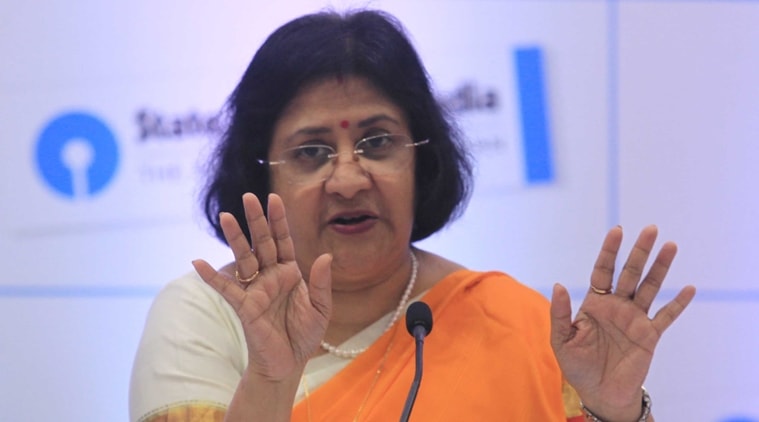Getting people out of cash is a tough, long exercise, it’s not going to happen in a day: Arundhati Bhattacharya
In an interview with Indian Express, the SBI chief also made a case for a charge or levy on banking transactions to disincentivise cash dealings.
 Arundhati Bhattacharya, Chairman, SBI. (File Photo)
Arundhati Bhattacharya, Chairman, SBI. (File Photo)
Arundhati Bhattacharya, chairman of State Bank of India (SBI), which controls over 20 per cent of the banking business in India, says normalcy is slowly returning to the banking sector hit by demonetisation of Rs 500 and Rs 1,000 notes. Recycling of cash and introduction of more Rs 500 notes will improve the situation further, she says.
In an interview with Indian Express, the SBI chief also made a case for a charge or levy on banking transactions to disincentivise cash dealings.
What’s the impact of demonetisation on the economy?
If you look at the economy, with such a large step, obviously there will be immediately some impact. That’s already seen. You have seen people deferring any kind of discretionary spending and demand itself going down. As demand goes down, you will see prices come down. Prices of daily things like vegetables have come down quite a lot. This is reflected in your inflation numbers as well. The impact on the economy that was expected is already happening.
How will it impact on a longer term basis… it’s very difficult to say at this point of time. Nothing really impacts in one month’s time. We have to see either how quickly people change their habits or they get back to the way they were transacting earlier.
Should there be a banking transaction tax like what was introduced in 2005?
Why not? Those days there was difficulty because people didn’t have bank accounts. Today, the latest survey says 91 per cent of households have bank accounts. Even today, as we speak we are opening a lakh accounts per day. Previously we were opening around 60,000 accounts per day. If you want to put a transaction tax, it could probably go better than it happened in the past. If you want to deemphasise cash, then people should not only have an incentive for going digital, but also a disincentive for doing cash.
Cash imposes a heavy burden. We don’t understand because it’s not immediately visible. It’s a heavy burden on the society. Why should a country not get its rightful share of revenues? Why should a country have to take on itself a huge burden of managing a totally cash economy? It’s costly. Cash is not cheap. The physical infrastructure is not easy to maintain and cheap.
The demonetisation move and digitalisation drive and the potential loss of business should take a toll on the profitability of banks in the near term. Isn’t it? Do you expect the government to compensate?
Our huge infrastructure that we need for keeping cash is very expensive. If we can take the impact the way some of that and put more people into value added transactions, to some extent it will help us. There’s a cost to this. The cost is something that will impact us immediately. That cost is something that the government look at and then try and see what they can do to help us with it. There’s cost for the amount of business that we have lost during these days. We have not done our regular business. There’s a cost to the staff staying overtime. There’s cost to ATM recalibration. There’s a cost to security, transportation… all of these have costs. This is a cost that’s going to come to the bottom line. This is where the government can do a little handholding or make good some these. That would be very much appreciated.
There was a cost for two weeks of CRR (cash reserve ratio). We didn’t get any interest but on the other side, we have to pay the depositors the interest. That comes directly to your bottom line. We would very much like the government to appreciate what’s being done and to see whether some help can be given.
Have you communicated about this to the government?
We have not completed the exercise. The costs are still to be computed. Once they are computed, we will definitely communicate. Let’s finish doing the job and then we can communicate.
Do you think one of the challenges now is hoarding of currency?
No. The RBI is saying whatever currency public is getting, they are not spending. That’s a fact. They are not spending. People want to hold on to notes in case there’s a shortage. They are not comfortable in spending Rs 2000 note because they are getting back too much of exchange. Counting 5 or 6 notes is easy but if you have to count 18 notes, it’s not so easy. They will make mistakes… 3 or 4 of them will fall to the ground. People don’t like those difficulties. People would not like to spend Rs 100 note because they would like to have small cash in hand. They would like to spend Rs 2000 note but it’s difficult because not many things cost Rs 2000.
When do you expect the shortage to come down and normalcy to be achieved?
Once this Rs 500 note comes in, this instinct to hoard will come down to a great extent. But given the amount of notes that we have pushed out into the market, to that extent this recycling of note is not happening. When traders get something after they sell, they are not putting it into the bank as they normally would do. They are holding it with them because there’s a restriction on the amount they can withdraw per week. The recycling of note to the extent we want is not there because of these checks and balances or rather because of these restrictions that have been imposed… of not being able to take Rs 2500 per day from ATM or Rs 24,000 from your bank account. Because of these things people are putting back the cash that they are getting. They are holding it with themselves.
When do you think restrictions on cash withdrawal can be removed?
These restrictions will only go away when there’s sufficient amount of bank notes in the system. Until and unless that happens, they cannot take away the restrictions. The moment they take away the restrictions, everybody will want to go and draw out a lot. That becomes a problem.
Will money deposited remain with banks once restrictions are removed? Will the surge in deposits lead to cut in lending rates?
All these deposits will not stay back. Most of it will be drawn back. Every Indian keeps some amount, says Rs 30,000 or Rs 40,000, at home as a backup just in case of any emergency or whatever. All of that are coming into the banks. If you’re in the habit of keeping some amount of cash at home, you’re going to daw it back and keep it at home. Our own reckoning is that only 10-15 per cent will probably stay. We’re still a cash intense economy. Though we’re trying hard to modernise and become digital, it will take time. Ultimately it’s a cultural phenomena and it’s also a question of good infrastructure.
Digital transactions seem to have surged after demonetisation…
I’m sure people are already working on innovations where the phone will act as a PoS. The non-availability of PoS machines is not going to hold up the exercise. PoS transactions have gone up by three times. Wallet transactions have gone up by five times value-wise.
When do you hope to resume normal banking operations?
Slowly we’re getting back. We can’t afford not to do the regular business. Many of the teams have already been restored. By January 10-15, we will be fully back. Slowly the rush is also coming down. In most of the urban and metro areas, rush is very low. It’s there in some rural pockets. In rural areas, branches are smaller and the number people serving are lower… to that extent some rural areas still have some rush.
Do you think the government should disincentivise cash transactions?
The government has to find some ways to disincentivise cash transactions. You can always do that. If you have more than this much of cash transaction, there can be a charge on it. Not only on cash holdings, there should be a cess on cash transactions also. If I am going to draw cash from my account over and above certain amount, there should be a cost to it.
When can the country become a less-cash economy?
People are used to cash in our country. Getting them out is a tough long exercise. It’s not going to happen in a day’s time. This particular restriction that has happened is pushing many people. We have to continue to do something in order to keep up this push. Otherwise people will slowly latch back again. That’s where I feel we have to ensure there’s some kind of disincentive. You do it for small value it’s alright. For bigger transactions, you have to somehow find way ensuring those transactions don’t happen in cash. Definitely we need to see why people take out so much cash. And why we can’t convert more of these into digital.
There were reports about small units being hit by cash crunch. What’s your assessment?
It’s very difficult to say now. In one month, you don’t get daily reports on SMEs going bad units. It takes time. We will know in another 2-3 months’ time.
Why do you say we should move from cash to digital economy?
It’s without doubt that India has become very cash intense. If you look at our own in-house reports, you can see that cash with public was increasing enormously. It’s also a fact that the cash that we were giving from our counters was also increasing on a year-by-year basis. Cash intensity was going up, and not coming down in spite of the fact that we have every other digital mode for doing things.
The fact remains that infrastructure in many parts of the country may not be as robust as we would have liked it to be. That could be one of reasons why digital transactions had not really spread its roots in many rural areas. Even in urban areas, a huge number of transactions were going on in cash. Transactions in cash have disadvantages. One is cash transactions escape revenue net. Second, they don’t leave any footprint. Illegal transactions can happen if they are in cash. Third is actually there’s a huge cost to the economy. If you look at the cost of printing notes, sending them to banks, banks issuing them, getting them back, recounting them, re-circulating them and the physical network that is required – whether branches, ATMs and security – the more intense the economy is in cash the more is the pressure on the cost that it imposes on the economy. If you can move the economy to digital, many of these things get taken care.
So your transactions don’t escape the revenue net. If it doesn’t escape the revenue net at the end of the day, a country as large as India where there’s only a 4 per cent base of direct tax payers is too small. There’s something definitely wrong. Why should there be only 4 per cent of tax payers? It cannot be in a country this large with an economy which is growing at more than 7 per cent.
Will demonetisation and the move towards digital mode work?
Many of the transactions, if they are not in cash, can be captured and your revenue net can improve. If your revenue net goes up, then there are clear advantages — one is your infrastructure build and then the social sector infra. The government is able to undertake the infrastructure build. Second is that pressure on everybody will come down. If you are not able to capture everyone, then the few people who were captured the pressure on them is much larger. To move the economy out of cash to the extent feasible is a very laudable move. If that can be achieved, this exercise will still have a large positive impact on things going forward. Whether that can be achieved or not, only time will tell. I have no crystal ball to gaze at and tell you that it will happen. I think the goals very laudable and the means of achieving them are still not fully there. They are being put into place as we speak. Ultimately whether this is going to achieve the aim with which it was launched, we have to wait and see.
Banks were supposed to clean up their books by March 2017. In the backdrop of all these, won’t there be a rise in the level of bad loans.
Some amount of slippages will occur because of lack of follow-up. I don’t think you will see all of these this quarter. The RBI has given some relaxation to the banks to not immediately classify them. At the end of the day, it still needs to be followed up and obviously our ability to do that alongside the rest of the work that we are doing is a little limited.
Photos





- 01
- 02
- 03
- 04
- 05

























